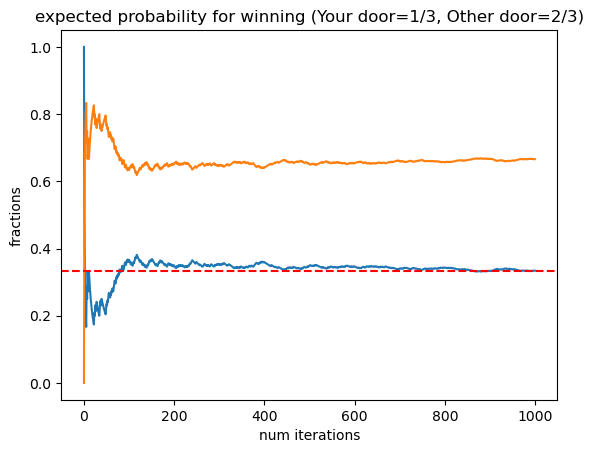Bayes’ Rule Exercises and Monte Carlo Method
Contents
Bayes’ Rule Exercises and Monte Carlo Method#
import pandas as pd
import numpy as np
import matplotlib.pyplot as plt
import random
# we have three doors
def monty_hall(num_iterations):
tot_wins = 0
Door_A_Win = 0
Door_Other_Win = 0
Frac_A_Win = []
Frac_Other_Win = []
for i in range(num_iterations):
doors = ['A','B','C']
# Participant always chooses Door A
door_participant = 'A'
# Randomly place the car behind one of the doors
door_win = random.choice(doors)
# Host opens a door that is not chosen by the participant and does not have the car
doors.remove(door_win)
if(door_win!=door_participant):
doors.remove(door_participant)
door_open = random.choice(doors)
if(door_participant==door_win):
Door_A_Win+=1
if(door_participant!=door_win):
Door_Other_Win+=1
Frac_A_Win.append(Door_A_Win/(i+1))
Frac_Other_Win.append(Door_Other_Win/(i+1))
return Frac_A_Win, Frac_Other_Win
num_iterations=1000
Frac_A, Frac_O = monty_hall(num_iterations)
plt.plot(Frac_A)
plt.plot(Frac_O)
plt.title("expected probability for winning (Your door=1/3, Other door=2/3)")
plt.axhline(y=1/3, linestyle='--', color='r')
plt.xlabel('num iterations')
plt.ylabel('fractions')
Text(0, 0.5, 'fractions')

Law of Large Numbers#
In probability theory, the LLN is a mathematical theorem that states that the average of the results obtained from a large number of independent and identical random samples converges to the true value, if it exists
Monte Carlo#
Calculate \(\pi\)#
# Calculate pi = 3.14...
def calc_pi(num_iterations):
n_in_circle = 0
n_in_square = 0
lis_points = []
lis_flag = []
for i in range(num_iterations):
flag_in_circle = False
point_in_square = np.random.uniform(-1.,1.,(1,2))
if(np.sqrt(point_in_square[0][0]**2+point_in_square[0][1]**2)<1):
n_in_circle+=1
flag_in_circle = True
lis_points.append(point_in_square)
lis_flag.append(flag_in_circle)
n_in_square = float(num_iterations)
n_in_circle = float(n_in_circle)
pi = 4.* n_in_circle/n_in_square
return pi, lis_points, lis_flag
num_iter = 20000
pi, points, flags = calc_pi(num_iter)
print(f"{pi:.6f}")
circle_points = [point for point,m in zip(points, flags) if m==True]
#print(circle_points)
#print(circle_points[:,0])
#plt.scatter(circle_points)
xs = [point[0][0] for point in points]
ys = [point[0][1] for point in points]
xc = [point[0][0] for point in circle_points]
yc = [point[0][1] for point in circle_points]
plt.scatter(xs,ys, color = 'blue')
plt.scatter(xc,yc, color = 'red')
plt.gca().set_aspect('equal', adjustable='box')
3.128600




